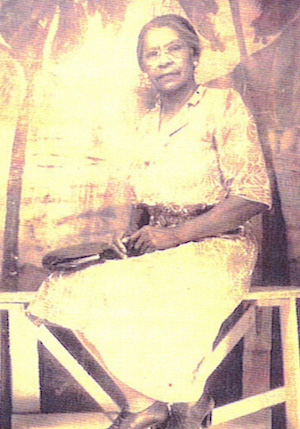
Martha Ann Jane Stevens Perkins Howell, born on January 20, 1875, was named for her maternal grandmother, Martha Vilate Crosby Flake, who had been a slave during the Mormon migration to the West. Martha Howell’s maternal grandfather was Green Flake, also born a slave, who was in the Vanguard Company for the Mormon pioneers. Martha’s mother was Lucinda Flake, and her father, of Mexican origin, was George Washington Stevens.
Black Mormons comprised a small group in the intermountain west, and the few families with many children constituted the largest marriage pool for blacks at a time where anti-miscegenation laws were solidly in place.
On October 11, 1899, Martha and her bridegroom, Sylvester Perkins, celebrated a double wedding with Louis Leggroan and Nettie James, granddaughter of Jane Manning and Isaac James. The Perkins family was also prominent. Sylvester Perkins was the brother of Jane James’s daughter-in-law and the son of Franklin Perkins, who had been briefly married to Jane James herself.
Born just ten years after the Civil War ended, Martha cared deeply about literacy and the empowerment it would bring to her family. She insisted that her children visit the library weekly and help their illiterate father learn to read. She and Sylvester owned a large farm in the Millcreek area of Salt Lake City.
Martha’s mother, Lucinda, had ceased activity in the Mormon Church after fellow members in Idaho Falls, Idaho, declared that they would not attend if a black person was present at church services. Martha, however, was actively LDS, though her life was lived during the years when the church did not allow black men to be ordained to its priesthood or to receive its exclusive temple ordinances. The church did not segregate its congregations, there were no all-black LDS stakes, but the policy implied differentiation between the races. This differentiation was based on the rationale that blacks had either been cursed as descendants of Cain and Ham or had been “less valiant” than whites in a pre-mortal life, thus making themselves unworthy of the priesthood in mortal lives.
Martha became a widow on March 9, 1934, and married Abner Howell in 1945. The new union led her into some prominence. Howell, the son of Utah’s first black policeman (Paul Cephas Howell), was acquainted with many church leaders, and his connections provided some stature to his new wife. The two were asked to go on a mission trip to the southern states to investigate the possibility of establishing black LDS congregations there. Church leader LeGrand Richards provided the couple with a letter to take to bishops of any congregations they might visit, asking that every courtesy be extended to them. Though no black congregations were formed, the trip afforded Martha the opportunity to visit Nauvoo, Illinois, an early Mormon settlement, where her grandfather, Green Flake, had once lived.
Martha’s daughter, Mary Lucile Perkins Bankhead, became the first president of the Genesis Group’s women’s organization, the Relief Society, when the group was established in 1971 as a support to Black Mormons living under the priesthood restriction.
On May 10, 1954, one week to the day before the Supreme Court announced its decision outlawing segregated schools in Brown v. The Board of Education, Martha Ann Jane Stevens Perkins Howell died. She is buried in the Elysian Gardens cemetery in Salt Lake City.

